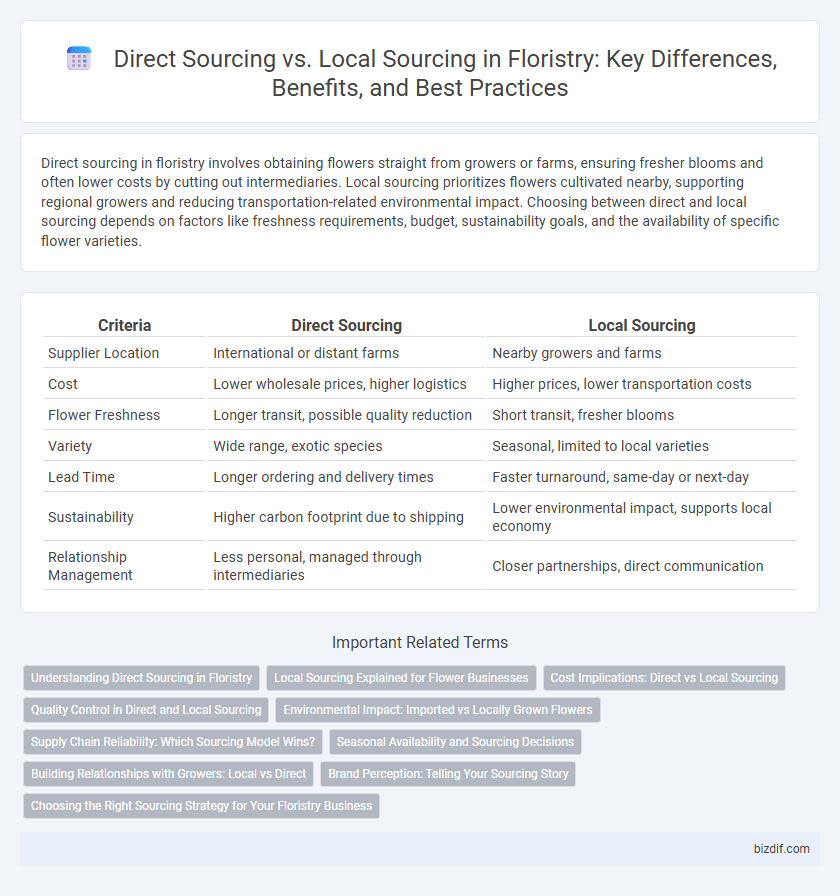Direct sourcing in floristry involves obtaining flowers straight from growers or farms, ensuring fresher blooms and often lower costs by cutting out intermediaries. Local sourcing prioritizes flowers cultivated nearby, supporting regional growers and reducing transportation-related environmental impact. Choosing between direct and local sourcing depends on factors like freshness requirements, budget, sustainability goals, and the availability of specific flower varieties.
Table of Comparison
| Criteria | Direct Sourcing | Local Sourcing |
|---|---|---|
| Supplier Location | International or distant farms | Nearby growers and farms |
| Cost | Lower wholesale prices, higher logistics | Higher prices, lower transportation costs |
| Flower Freshness | Longer transit, possible quality reduction | Short transit, fresher blooms |
| Variety | Wide range, exotic species | Seasonal, limited to local varieties |
| Lead Time | Longer ordering and delivery times | Faster turnaround, same-day or next-day |
| Sustainability | Higher carbon footprint due to shipping | Lower environmental impact, supports local economy |
| Relationship Management | Less personal, managed through intermediaries | Closer partnerships, direct communication |
Understanding Direct Sourcing in Floristry
Direct sourcing in floristry involves purchasing flowers and floral products straight from growers or producers, ensuring fresher stock and greater control over quality and variety. This method reduces intermediaries, leading to cost savings and the opportunity to build stronger supplier relationships tailored to specific design needs. Florists can benefit from exclusive access to unique blooms and seasonal varieties unavailable through local wholesalers, enhancing their creative offerings.
Local Sourcing Explained for Flower Businesses
Local sourcing in floristry involves obtaining flowers directly from nearby growers and farms, reducing transportation time and ensuring fresher blooms. This method supports regional economies, decreases carbon footprint, and enhances the quality and sustainability of floral arrangements. Flower businesses benefit from stronger relationships with local suppliers, faster restocking, and the ability to offer seasonal, unique varieties that resonate with community preferences.
Cost Implications: Direct vs Local Sourcing
Direct sourcing in floristry often reduces costs by eliminating intermediaries and securing flowers straight from growers, enhancing price control and minimizing markups. Local sourcing may involve higher expenses due to smaller-scale suppliers and increased logistics, but can reduce transportation costs and spoilage, supporting freshness and quality. Balancing direct and local sourcing strategies can optimize budget efficiency while maintaining flower quality and supply chain reliability.
Quality Control in Direct and Local Sourcing
Direct sourcing in floristry offers enhanced quality control by allowing closer inspection of flowers at the origin, ensuring freshness and adherence to specific standards. Local sourcing provides real-time quality assessment and quicker feedback loops, reducing the risk of damage during transit and supporting prompt corrective actions. Both methods emphasize rigorous quality control, with direct sourcing excelling in initial flower selection and local sourcing optimizing post-harvest handling and delivery.
Environmental Impact: Imported vs Locally Grown Flowers
Imported flowers often have a higher carbon footprint due to long-distance transportation and energy-intensive storage requirements, significantly impacting the environment. Locally grown flowers reduce greenhouse gas emissions by minimizing transportation distances and supporting sustainable farming practices adapted to the local ecosystem. Choosing local sourcing in floristry promotes biodiversity, conserves water resources, and lowers the overall environmental impact compared to imported florals.
Supply Chain Reliability: Which Sourcing Model Wins?
Direct sourcing in floristry enhances supply chain reliability by minimizing intermediaries, ensuring fresher and more consistent flower availability through direct grower partnerships. Local sourcing supports supply chain resilience by reducing transportation time and costs, leading to quicker replenishment and lower risk of delays. Evaluating supply chain stability, direct sourcing offers greater control over quality and inventory, while local sourcing excels in flexibility and rapid response to market demands.
Seasonal Availability and Sourcing Decisions
Seasonal availability plays a crucial role in floristry sourcing decisions, with direct sourcing offering access to global markets that provide a broader range of flowers year-round. Local sourcing, however, supports seasonal blooms that are fresher and more sustainable, often leading to enhanced flower quality and lower environmental impact. Balancing direct and local sourcing strategies enables florists to optimize inventory freshness while meeting customer demand for unique and sustainable floral arrangements.
Building Relationships with Growers: Local vs Direct
Building strong relationships with growers enhances flower quality and supply consistency, with direct sourcing fostering deeper partnerships through transparent communication and tailored orders. Local sourcing supports community growers by promoting sustainability and reducing carbon footprints, though it may involve more intermediaries in the supply chain. Florists prioritizing direct sourcing often benefit from firsthand insights and exclusive varieties, while local sourcing encourages regional economic growth and rapid availability.
Brand Perception: Telling Your Sourcing Story
Direct sourcing in floristry enhances brand perception by showcasing transparency and ethical practices, allowing customers to connect emotionally with the origins of each bloom. Local sourcing emphasizes community support and sustainability, reinforcing a brand's commitment to environmental responsibility and freshness. Sharing compelling sourcing stories builds trust and differentiates florists in a competitive market by highlighting authenticity and quality.
Choosing the Right Sourcing Strategy for Your Floristry Business
Direct sourcing in floristry involves procuring flowers straight from growers or farms, ensuring fresher blooms and potentially lower costs by eliminating intermediaries. Local sourcing prioritizes purchasing flowers from nearby growers or markets, supporting local economies and reducing transportation time and environmental impact. Selecting the right sourcing strategy depends on factors like flower availability, cost efficiency, quality requirements, and brand values focused on sustainability or freshness.
Direct sourcing vs local sourcing Infographic

 bizdif.com
bizdif.com